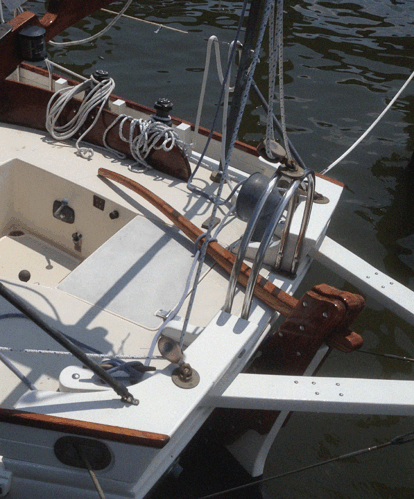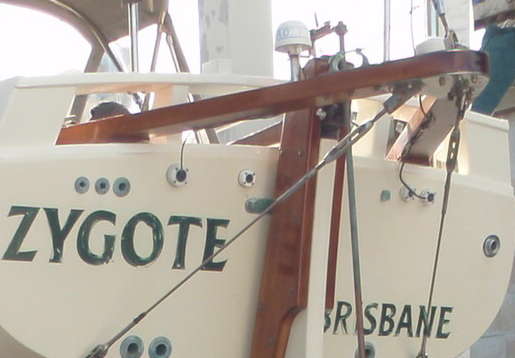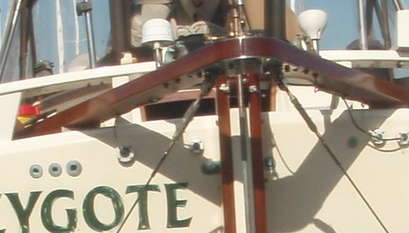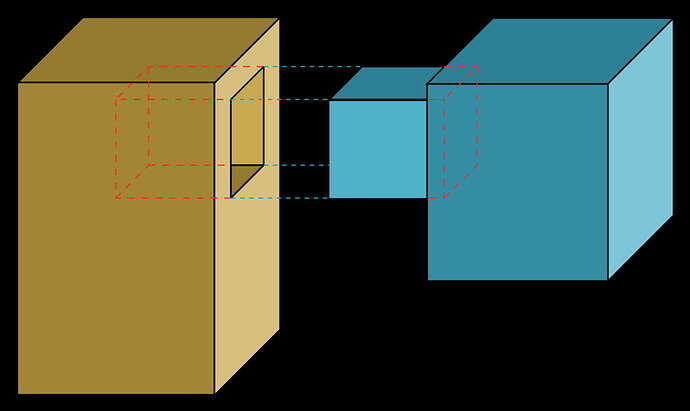Apologies, Mike, for confusing you.
The tiller + rudder is a tenon and mortise joint.
I was picturing the cleats on the tiller as resting against the forward side of the rudder cheeks to prevent the tiller from sliding aft.
Yes, that’s right. You’ve got it.
But are you saying there is a hole through the tiller with a tenon sliding through (like the fid in the bowsprit)?
No.
‘Tenon’ is likely a proto-Indo-European word that stretches back a long way and holds language histories together. The word was borrowed into English from Old French and in those and related languages (all the way back to Greek) means 'something that holds on, holds things together.
Think of closely related words in English, such as ‘tenant’ (a person who holds onto the landlord’s property temporarily).
The PIE original word, meaning the root word that we can just barely trace to a multi-cultural mob of peoples living near the junction of the Eurasian steppes and the little peninsula that sticks to the west off the Eurasian continent, clearly had the ‘ten’ sound and probably meant ‘to stretch’ (hence English ‘tension’.
At least one of that mob of polyglot PIE speakers moved south into the Balkans, carrying the word and concept with them.
The traditional cabinetry mortise and tenon joint is the attached image (mortise and tenon.jpg). The stock on the right (in blue) could be stone or timber. The worker cuts into that stock to create shoulders and the thin tenon (the protruding piece - which is like the thin neck protruding from the shoulders of the wider trunk.).
In the case of a tiller, you cannot afford to cut into the stock to make shoulders and a thin tenon. That cutting would weaken the whole tiller; its strength would be determined by the size of the tenon.
So for a tiller (in contrast to most cabinetry mortise and tenon joints), strength is everything. Most cabinetry is not about massive leverage at the joint. The tiller/rudder joint is all about leverage.
The whole tiller is the tenon. And the added cleats (to stop the tiller moving aft) are the shoulders of the piece.
Now let’s consider ‘mortise’. The English word comes from the French, but this time not directly from a proto-Indo-European (PIE) word that became Greek, then Latin, then French before English.
‘Mortise’ is more likely a Semitic word, with its oldest surviving descendant probably being Arabic ‘mortazza’- ‘to be fastened together’. That Arabic word gets left behind in Spanish as ‘mortaja’ - ‘a socket to accept a pin or a tenon’.
So we can call the slot in the inboard end of the bowsprit a mortise. But we call the peg we put through it a fid, not a tenon. The fid acts as an added shoulder, to bear compression forces transmitted to the bowsprit from the headstay and bobstay. So the fid is not joining, not making a joint. It’s acting as a shoulder to interfere with forces pushing the bowsprit aft.
The fid in the bowsprit is acting almost the opposite way to the tiller retaining cord running through the drilled hole in most BCC tillers. The retaining cord (or the throughbolt that you have penetrating both your rudder cheeks and your tiller) acts to interfere with any tension force pulling the tiller forward.
In the case of your BCC, you likely do not have shoulder cleats attached to your tiller, because that throughbolt does two jobs: stopping the tiller moving aft (the job of shoulders attached to other BCC tillers); and stopping the tiller moving forward (the job of a tiller retaining cord on other BCC tillers).
So your throughbolt is a neat solution. It’s a more expensive option (than a length of short stuff and two small cleats plus wood screws), but neat. Keeping it as a throughbolt, or changing it to a throughbolt held in place by a split pin, ring, or whatever, is also a neat solution that gives your BCC its own character.



